General Cast Net Information
Wherever you may fish, live bait is always the best lure. To save time and money, you need to keep live bait ready. Cast netting is the most economic tool for catching your own bait. You can also use a cast net to catch shrimp, larger fish, mullet, etc.
Cast nets have been used for thousands of years. A good example of cast netting in antiquity is after His resurrection, Jesus tells his disciples to "'Throw your net on the right side of the boat and you will find some.' When they did, they were unable to haul the net in because of the large number of fish." (John 21:6 NIV).
Cast netting is very popular, either in fresh or salt water, and can be used in different applications from Sport to Commercial fishing. Many people use cast nets, from kids to experienced professional fishermen, almost everywhere in the world.
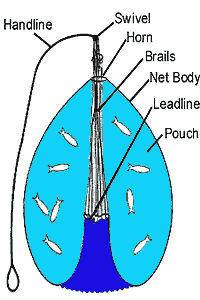
Basic Cast Net Structure
- Swivel: two metal loops or rings attached together, that turn at both ends.
- Hand line: a rope which is attached to the swivel on one end, with the other end attachded to the caster's wrist.
- Horn: a ring with an indentation around the center, where the top of the net is tied.
- Lead Line: a rope with sinkers attached. This rope is at the outside perimeter of the net to sink it.
- Brail Lines: lines attached to the swivel at one end and to the leadline at the other. Their function is to pucker the net, thus trapping the catch.
- Netting: made from nylon multifilament or monofilament to form the desired mesh.
How Cast Nets Work
Throwing the net creates a driving force that causes the lead line to open the net to a flat form, the lead weights then sink the net. After the net has sunk, and the brail line is pulled, the lead line is forced to close,thus, creating a pouch in the net which holds the catch, trapping a school of shrimp or fish. After pulling the net from the water, opening the leadline will cause the catch to fall out.
Choosing Nets Correctly
Depending on what kind of catch is targeted, i.e. shrimp, pin fish, shiner, mullet, sardine, etc., the correct size of mesh and net will provide more accurate hauls. As with any fishing equipment, the bigger the targeted catch, the bigger size of mesh and stronger netting material needed.
Please use the following table as a guideline:
| BAIT SIZE | MESH SIZE | NET BREAK STRENGTH |
|---|---|---|
| 1" - 3" | 1/4"SQ (1/2" STR.) | 5 - 9 LBS |
| 3" - 6" | 3/8" SQ (3/4" STR.) | 7 - 15 LBS |
| 6" - 9" | 1/2 " SQ ( 1" STR.) | 9 - 20 LBS |
| 9" - 12" | 5/8" SQ (1-1/4" STR.) | 12 - 25 LBS |
| 12" OVER | 1" SQ. OVER (2" STR. and OVER) | 20 LB and OVER |
Cast Net Care
The most important thing in cast net care is rinsing your net after every use. Washing the net not only washes away the salt water; it also removes fish particles and slime remaining on the net. The fish slime is particularly harmful in deteriorating the net. Simply rinse well with a garden hose and allow the net to dry. Then place the net into a bucket or any other dry storage area.
Sunlight is another harmful element to the cast net. Do not allow your cast net to stay in the sunlight for long periods of time. This is especially important for monfilament cast nets. Overexposure to sunlight will cause the netting to become brittle and weak.
Another secret in cast net care is fabric softener. By using fabric softner you can prevent the net from becoming stiff and help in the overall spread of the net. Just take a pail of water, add a cup of softener, and place the cast net in the pail, for about one hour. Remove the net, rinse, and store the net after it dries. This process should be done when the net is first purchased and repeated every six to eight months.
Finally, just inspect your net occasionally, checking for any holes or weak areas. You, or your local net shop can repair these areas. If repairing the net yourself, "How to Make and Mend Cast Nets" by Ted Dahlem can be a helpful tool. Also, you may contact us for any twine, netting, or needles that are used in any repairs.
How to throw a cast net
There are many different ways to throw a cast net. If you ask 5 people you will likely get 5 different methods of throwing it. So to get you started, here is one for you, demonstrated for those who are right handed.
-
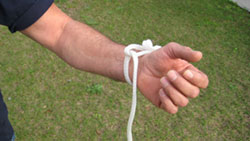
-
1.Attatch the end of the hand line to your wrist by either slide your hand through the loop at the end or make a second loop as shown then attatch to wrist.
-
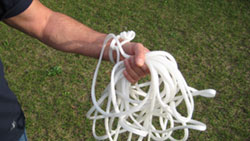
-
2.Collect the rest of your hand line and hold it in the same hand.
-
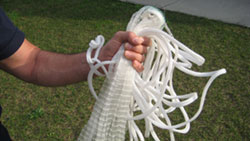
-
3.Grab on to the top of the cast net, just below the horn.
-
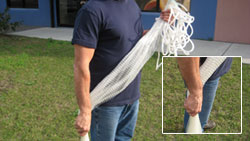
-
4.With your right hand, straighten up the net and slide your right hand down by your right hip.
-
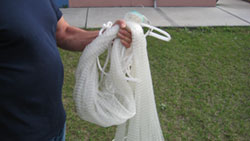
-
5.Take the webbing on your right hand and place it in your left hand with the rest of the net handing over.
-
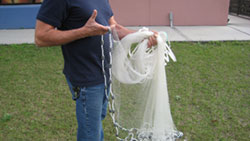
-
6.Pick up the section of lead line closest to you.
-
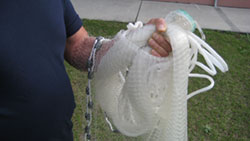
-
7.There are many people who like to put the LEAD line in their mouth...not sure why, but for the sake of health and this tutorial, we will throw this section of lead line over your left arm. The effect is the same.
-
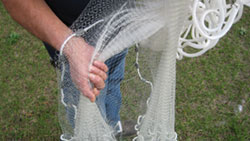
-
8.Now, with your right hand, reach under the cast net and grab about half of the net. So you'll end up with about half the weight on your left hand and half on the right.
-
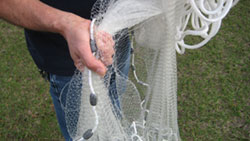
-
9.Use your fingers and move the lead line so that it is enclosed in your right hand.
-
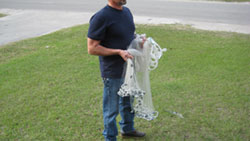
-
10.Face your target area with both hands up at around elbow height.
-
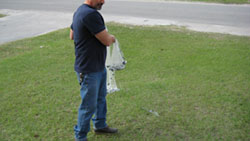
-
11.Swing the cast net about 45 degrees to your left while keeping your foot stationary.
-
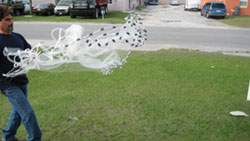
- 12.Throw! Release right hand first immediately followed by left while keeping your left hand close to your body.
-
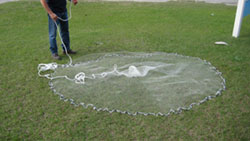
-
13.Your cast net should open up as shown. Now just wait around 10 seconds until the net sinks to the bottom and pull up by the hand line.If you've picked a good spot, you will have all the bait you need!

